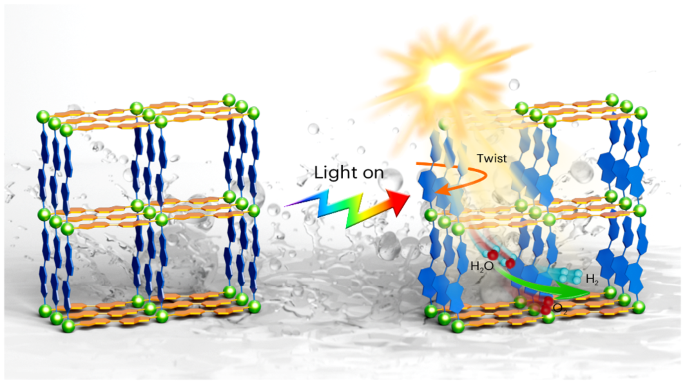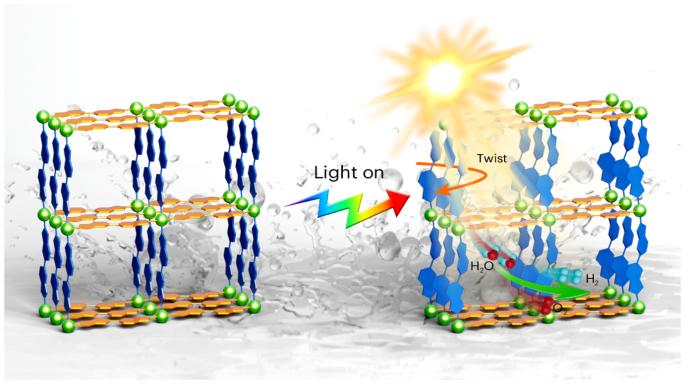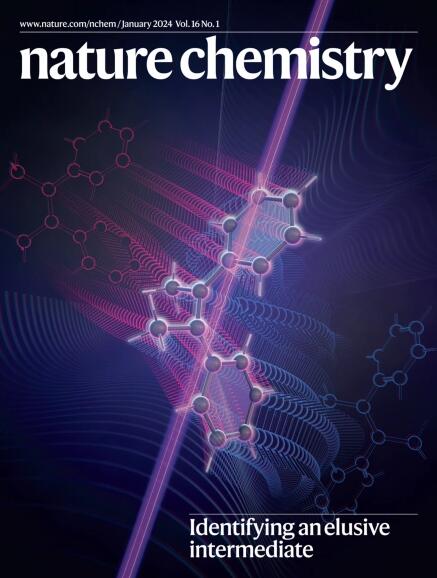金属有机框架的动态结构扭曲增强了太阳能整体水分离能力
IF 19.2
1区 化学
Q1 CHEMISTRY, MULTIDISCIPLINARY
引用次数: 0
摘要
光催化整体水分离为太阳能转化为氢气带来了巨大前景。保持电荷分离是一项重大挑战,但也是释放这一潜力的关键。在这里,我们发现了一种可抑制电荷重组的金属有机框架(MOF)。这种 MOF 具有电子绝缘的 Zn2+ 节点和两个化学等价但晶体学上独立的连接体。这些连接体作为一对电子供体-受体,具有不重叠的带边。光激发时,MOF 会发生动态激发态结构扭曲,诱发轨道重排,禁止辐射弛豫,从而促进长寿命的电荷分离态。因此,在助催化剂存在的情况下,MOF 实现了可见光光催化整体水分离,在 365 纳米波长下的表观量子效率为 3.09 ± 0.32%,并且在连续运行 100 小时后活性几乎没有下降。此外,动态激发态结构扭曲还成功地扩展到了其他光催化剂。这种抑制电荷重组的策略将适用于整体水分离以外的各种光化学过程。本文章由计算机程序翻译,如有差异,请以英文原文为准。


Dynamic structural twist in metal–organic frameworks enhances solar overall water splitting
Photocatalytic overall water splitting holds great promise for solar-to-hydrogen conversion. Maintaining charge separation is a major challenge but is key to unlocking this potential. Here we discovered a metal–organic framework (MOF) that shows suppressed charge recombination. This MOF features electronically insulated Zn2+ nodes and two chemically equivalent, yet crystallographically independent, linkers. These linkers behave as an electron donor–acceptor pair with non-overlapping band edges. Upon photoexcitation, the MOF undergoes a dynamic excited-state structural twist, inducing orbital rearrangements that forbid radiative relaxation and thereby promote a long-lived charge-separated state. As a result, the MOF achieves visible-light photocatalytic overall water splitting, in the presence of co-catalysts, with an apparent quantum efficiency of 3.09 ± 0.32% at 365 nm and shows little activity loss in 100 h of consecutive runs. Furthermore, the dynamic excited-state structural twist is also successfully extended to other photocatalysts. This strategy for suppressing charge recombination will be applicable to diverse photochemical processes beyond overall water splitting. Solar water splitting holds great promise for hydrogen production but is significantly hindered by rapid recombination of photogenerated charges. Now a metal–organic framework photocatalyst has been shown to undergo, upon photoexcitation, a dynamic excited-state structural twist that greatly suppresses charge recombination to enable efficient photocatalytic overall water splitting.
求助全文
通过发布文献求助,成功后即可免费获取论文全文。
去求助
来源期刊

Nature chemistry
化学-化学综合
CiteScore
29.60
自引率
1.40%
发文量
226
审稿时长
1.7 months
期刊介绍:
Nature Chemistry is a monthly journal that publishes groundbreaking and significant research in all areas of chemistry. It covers traditional subjects such as analytical, inorganic, organic, and physical chemistry, as well as a wide range of other topics including catalysis, computational and theoretical chemistry, and environmental chemistry.
The journal also features interdisciplinary research at the interface of chemistry with biology, materials science, nanotechnology, and physics. Manuscripts detailing such multidisciplinary work are encouraged, as long as the central theme pertains to chemistry.
Aside from primary research, Nature Chemistry publishes review articles, news and views, research highlights from other journals, commentaries, book reviews, correspondence, and analysis of the broader chemical landscape. It also addresses crucial issues related to education, funding, policy, intellectual property, and the societal impact of chemistry.
Nature Chemistry is dedicated to ensuring the highest standards of original research through a fair and rigorous review process. It offers authors maximum visibility for their papers, access to a broad readership, exceptional copy editing and production standards, rapid publication, and independence from academic societies and other vested interests.
Overall, Nature Chemistry aims to be the authoritative voice of the global chemical community.
 求助内容:
求助内容: 应助结果提醒方式:
应助结果提醒方式:


